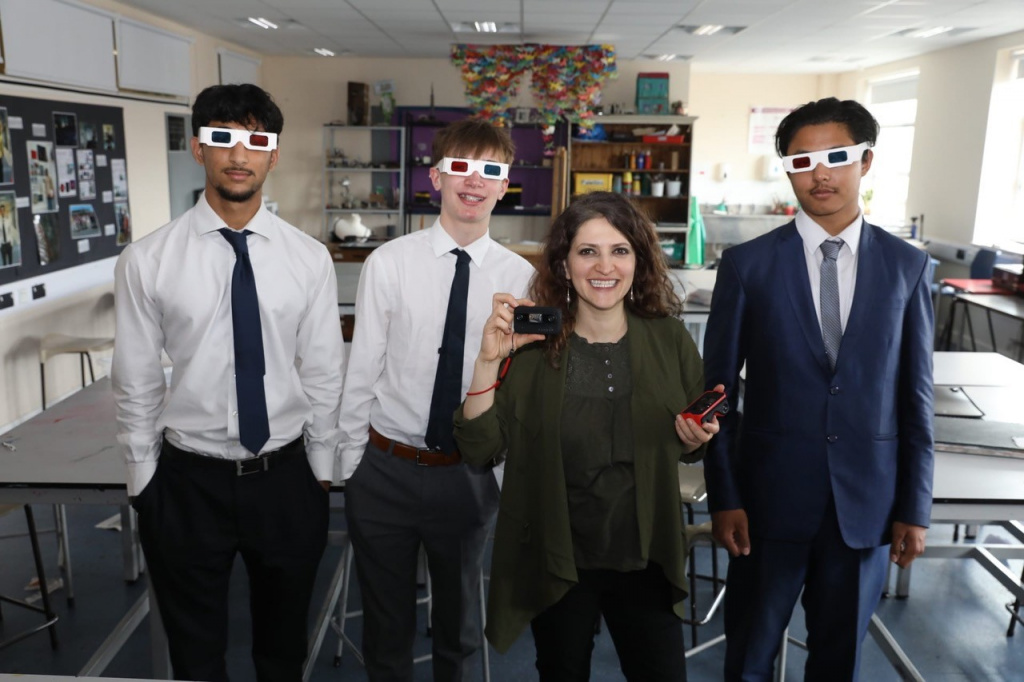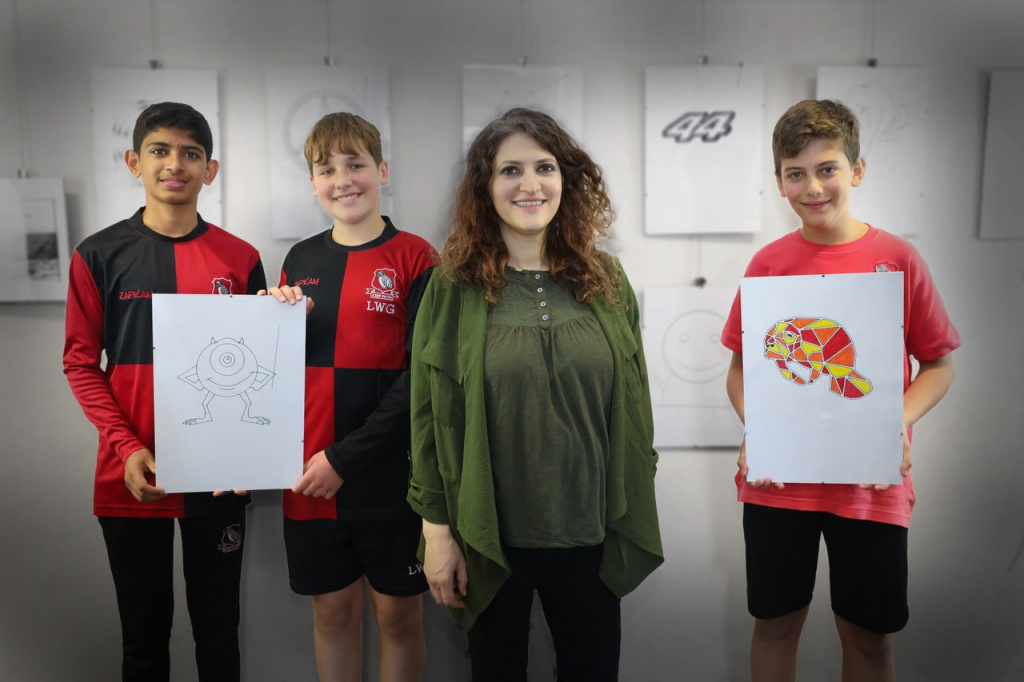
As an art teacher and a multi-disciplinary artist, I have embarked on a mission to bridge the gap between arts and technology, transforming the landscape of my STEM-focused school’s art and photography department. To do so, I have integrated cutting-edge technologies like artificial intelligence, robotics and stereoscopy into the curriculum, unlocking boundless creativity and empowering students for future careers in the digital age.
Nurturing Ethical Innovators
In the ever-evolving landscape of art education, my commitment as the Head of the Art & Photography Department extends beyond conventional boundaries. An integral component of our curriculum involves equipping students with the skills to harness the power of artificial intelligence (AI) in the creation of art. By delving into the nuances of AI art, we initiate critical conversations on ethics, creative applications and the broader advantages and responsibilities that come with wielding such transformative technologies.
Our students are not just taught how to create AI art; they are guided through an exploration of the ethical considerations that accompany this cutting-edge medium. Understanding the implications of AI-generated art on copyright and originality encourages a thoughtful approach to creativity. We delve into the why and how of AI art, fostering a deep appreciation for the technology’s potential while instilling a sense of responsibility in its application.
The lessons commence with an introduction to the ethical dimensions of AI art. Students delve into discussions on the impact of AI-generated art on copyright, intellectual property and the broader artistic landscape. This initial phase lays the foundation for understanding the profound implications of their creative endeavours.
Once students grasp the ethical framework, they are encouraged to explore the creative applications of AI in art. Interactive discussions and case studies showcase how artists navigate the balance between innovation and ethical responsibility. This phase prompts students to consider the artistic possibilities while respecting ethical boundaries.
Structured class discussions and debates become the forum for deeper exploration. Students are prompted to critically analyse real-world scenarios, considering the consequences of AI in various contexts. They engage with ethical theories, guiding them to form their own perspectives and articulate nuanced viewpoints.
Our cross-disciplinary endeavour not only nurtures artistic prowess but cultivates critical thinking skills as students grapple with the ethical dimensions of AI. By integrating technology into the artistic process, we unlock new realms of creative expression, pushing the boundaries of conventional art-making. Through this approach, our students emerge not merely as artists but as ethical innovators, ready to navigate the complex intersection of art, technology and societal impact.
Robotics in the Art Room
At the heart of the transformation of our department also lies the implementation of a drawing robot – the XY-plotting AxiDraw pen plotter. This ingenious device became a tool for artistic expression and a gateway for interdisciplinary collaborations. By teaching students to harness mathematical equations to create art, they not only explored the intersection of art, mathematics and computer science but also gained valuable insights into the world of robotics and automation.
The foundation of the AxiDraw lessons involves teaching students how to input and manipulate mathematical equations using the Desmos graphic calculator. Through interactive sessions, they learned to translate their creative visions into tangible instructions for the robot. This initial step laid the groundwork for a comprehensive exploration into the world of automation.

As students experimented with the AxiDraw, they witnessed the precision and accuracy with which the machine executed their commands. This real-time observation allowed them to appreciate the role of automation in achieving intricate and complex artistic outcomes. From geometric patterns to free-flowing designs, students grasped the potential of automation in realizing their artistic aspirations.
Working with the AxiDraw also presented challenges inherent in automation processes. Students encountered issues related to precision, timing and the translation of artistic intent into machine-executable commands. These challenges became learning opportunities, encouraging problem-solving and critical thinking as they navigated the nuances of automation.
The impact has been profound. Students learned to navigate the intricate dance between art and technology but also developed critical creative skills necessary in all professions. This hands-on experience has proven invaluable, providing a glimpse into the future job market where proficiency in such technologies will be a necessity. The utilisation of maths in art creation not only sparked creativity but also instilled a deeper appreciation for the role of technology in the artistic process.
A 3D Journey Through Time
A distinctive facet of our art and photography curriculum lies in the integration of stereoscopy in a historical context. The transformation of traditional 2D art historical images into three dimensions enriches our art history lessons with immersive depth and dimensionality. Pioneering this novel approach brings art history to life and makes it more engaging and accessible for our students.
In a bid to redefine the way we perceive and interact with art, students have not only delved into historical masterpieces but have also actively participated in the creation of 3D stereoscopic images. Leveraging the LeiPix AI tool, students seamlessly translated their own 2D artworks into mesmerising 3D representations. This innovative fusion of technology and artistic expression not only deepened their understanding of art but also fostered a newfound appreciation for the evolution of artistic styles over time.
This transformative journey through art history has redefined the traditional classroom experience. The integration of stereoscopy has elevated the educational landscape, providing students with a unique and immersive perspective that transcends the confines of PowerPoint presentations with static images. Through these interactive lessons, we aim not only to educate but to inspire, instilling a lifelong passion for art and its rich historical tapestry in each student.
Impact on Careers and Beyond
The impact of these innovations extends beyond the classroom, shaping the future prospects of our students. Collaborations with prestigious institutions, exhibitions at the Royal Academy of Art, the establishment of an Instagram page, and a 3D virtual gallery showcase the talent nurtured within our classrooms. To exhibit students’ work, we have used Artsteps for online group shows and have had GCSE students use this tool as well as QR codes to showcase their work. We have also collaborated with a juvenile detention centre in Baltimore, Maryland by digitally exchanging artworks in order to jointly create art which centred around the notion of hope.
By embracing technology, we have established a dynamic online presence, connecting with the global art community and motivating a new generation of learners. Witnessing their evolution from novices to polymaths, I have seen graduates secure placements in leading universities with major scholarships and awards, proving that a foundation in both arts and technology is a formidable advantage.
Nino Trentinella is Head of the Art and Photography Department at Sutton Grammar School. She is also a USA Presidential Award-winning teacher, a recognised specialist in blended learning and AI art and the winner of Pearson’s Award for Digital Innovator of the Year for 2023.
IG: NINOgraphyArt
Register for free
No Credit Card required
- Register for free
- Free TeachingTimes Report every month